

Paraphrase - Using Evidence. Paragraph With Paraphrased Material Not Integrated The causes of childhood obesity are various.
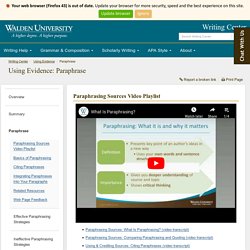
Greg (2005) found that children need physical activity to stay healthy. One study found that the amount of time spent in front of the television or computer had a direct correlation to an individual's BMI (Stephens, 2003). Parsons (2003) debated whether nature or nurture affects childhood obesity more. Scientists have linked genetics to obesity (Parsons, 2003). Here there is a list of paraphrased sentences, but again they seem to be missing any links or connections to show how the different ideas are related. Paragraph With Paraphrased Material, Revised (Revisions in Bold) The causes of childhood obesity are various.
Adding transitions allows the author to make connections while still presenting the paraphrased source material. Sign In. Coursework to Capstone: Writing Center Support for Doctoral Students. Home - SMRTguides. Home - Writing for Social Change in the Capstone. Writing Resource Matchmaker text version (1) General Guidance on Data Displays. By Tim McIndoo, Dissertation Editor According to APA style, a table has a row–column structure; everything else is called a figure (chart, map, graph, photograph, or drawing).
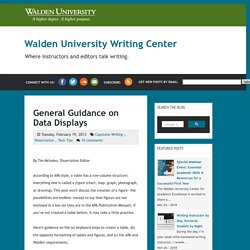
This post won't discuss the creation of a figure—the possibilities are endless—except to say that figures are not enclosed in a box (as they are in the APA Publication Manual). If you’ve not created a table before, it may take a little practice. Here’s guidance on the (a) keyboard steps to create a table, (b) the opposite formatting of tables and figures, and (c) the APA and Walden requirements. A. In the Word toolbar, go to Table > Insert > Table > Table size. Under AutoFit behavior, try AutoFit to Contents.
Under Table Style, try Table Normal. B. C. All cells in a table, and callouts in a figure, use sentence case.APA style does not use boldface type or vertical lines in tables.Do not put a box around a figure.Make titles and captions concise, clear, and expressive. The Podcast Returns! WriteCast Episode #5: Five Strategies for Critical Reading. Thanks to your feedback last year, we will be continuing the WriteCast podcast into 2014!
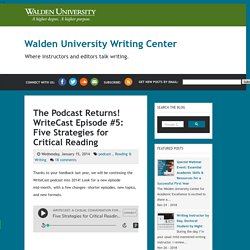
Look for a new episode mid-month, with a few changes--shorter episodes, new topics, and new formats.In our first episode of 2014, Nik and Brittany talk about a critical aspect of the writing process that students often overlook: critical reading. Tune in to learn five strategies to help you become a more critical and engaged reader. To download the episode to your computer, press the share button on the player above, then press the download button. BLOG: Walden University Writing Center. Citing Yourself - Citations. If you cite or quote your previous work, treat yourself as the author and your own previous course work as an unpublished paper, as shown in the APA publication manual.
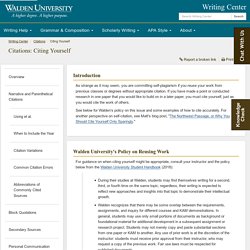
For example, if Marie Briggs wanted to cite a paper she wrote at Walden in 2012, her citation might look like this: Briggs (2012) asserted that previous literature on the psychology of tightrope walkers was faulty in that it "presumed that risk-taking behaviors align neatly with certain personality traits or disorders" (p. 4).
And in the reference list: Briggs, M. (2012). HAT: Historic Alignment Tool: Walden Resources. CHANGE MATRIX - DBA Program. Overview - Using Evidence. One of the central features of scholarly writing is the use of evidence to make an argument.
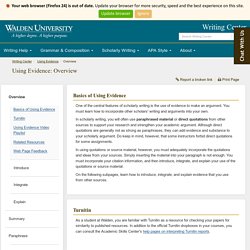
You must learn how to incorporate other scholars' writing and arguments into your own. In scholarly writing, you will often use paraphrased material or direct quotations from other sources to support your research and strengthen your academic argument. Although direct quotations are generally not as strong as paraphrases, they can add evidence and substance to your scholarly argument.
Do keep in mind, however, that some instructors forbid direct quotations for some assignments. In using quotations or source material, however, you must adequately incorporate the quotations and ideas from your sources. On the following subpages, learn how to introduce, integrate, and explain evidence that you use from other sources. Capitalization - Other APA Guidelines. Quick Guide Grammar and Syntax Feedback for Student Writing.
Meal plan 2 1.original. Organization (MEAL Plan) - Paragraphs. Overview - Scholarly Writing. Scholarly writing is also known as academic writing.
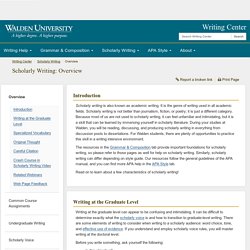
It is the genre of writing used in all academic fields. Scholarly writing is not better than journalism, fiction, or poetry; it is just a different category. Because most of us are not used to scholarly writing, it can feel unfamiliar and intimidating, but it is a skill that can be learned by immersing yourself in scholarly literature. During your studies at Walden, you will be reading, discussing, and producing scholarly writing in everything from discussion posts to dissertations. Working With Multilingual Writers - Tips & Tools.
For Undergraduate, Graduate, and Precapstone Multilingual Writers: Paper Review Appointments: Students can make appointments with a Writing Center Instructor to get individualized feedback on their work.
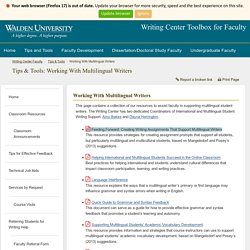
Instructors typically provide feedback and instruction on a range of writing-related issues to help students improve both the draft they are working on as well as their academic writing skills. Paper reviews are available for all undergraduate students, all graduate students, and all PhD students at the precapstone stage up through the prospectus. Overview - APA Style. When you are writing as a student, you are entering into a new writing community; just as you would need to learn the customs and rules of any new country you visit, you need to learn the customs and rules of academic writing.
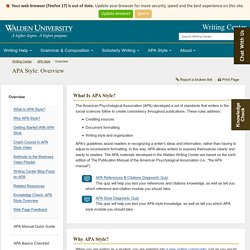
These guidelines will be different than guidelines for writing in other environments (such as letters to friends, e-mails to coworkers, or writing for blogs). The academic community has its own rules. General Templates - Walden Templates. Accessing Grammarly - Grammarly. Once you’ve logged into Grammarly, you will see the home page for your Grammarly account.

To start your review, click the New button. You are now ready to copy and paste your material into the white space using the Paste button. You can also upload your document into Grammarly. Once your text is pasted into the white box, Grammarly will automatically begin reviewing your text. If you use the upload option, Grammarly will upload your work and instantly provide a review. Select the type of paper you are checking. Year-In-Review: Walden University Writing Center 2017. As 2017 comes to a close, we in the Writing Center are reflecting on our services for the Walden community this past year: what new offerings we have created and new staff we have added, and how we have organized our center to best meet student writing needs.
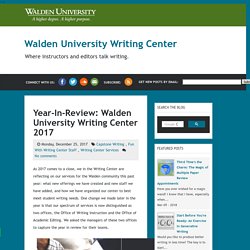
One change we made later in the year is that our spectrum of services is now distinguished as two offices, the Office of Writing Instruction and the Office of Academic Editing. We asked the managers of these two offices to capture the year in review for their teams. We also asked Kelly and Tobias what they wanted students to know about the editor team. We also spoke with Rachel Willard, who manages the Office of Writing Instruction alongside Anne Shiell. Rachel mentioned that the most common query among students who request paper reviews, visit our live chat, or e-mail us at writingsupport@waldenu.edu is “Can you help me with my APA?”
Organizational Tools - Common Assignments - Academic Guides at Walden University. Copyright dissthesis ownership. Plagiarism Prevention Modules - Modules. Plagiarism can refer to a wide range of academic integrity issues both inside and outside of academic writing. The Writing Center’s plagiarism prevention modules focus specifically on the appropriate ways writers should incorporate and cite sources they use in their writing. In these modules you will: Explore examples of plagiarism, Practice the appropriate way to cite sources to avoid plagiarism, and Learn about possible writing habits that might encourage or contribute to a writer plagiarizing.
These modules do not talk about how to use TurnItIn. For help with TurnItIn, visit the Academic Skills Center. Walden Writing Center - Avoiding Plagiarism Resources (800+)
Faculty Webinar Archive - Faculty Development. Painless Paragraphs: The NO TEARS Plan for Composing Academic Prose. Strong paragraph organization is the key to effective synthesis and logical flow of ideas in academic writing. If you’ve heard us talk about paragraphing before, you’ve likely heard of the MEAL plan. A new mnemonic device for paragraphing, called the NO TEARS plan, can also help guide you as you craft an argument paragraph by paragraph. Read on to learn more.
The Walden Writing Center teaches a paragraphing tool called the MEAL Plan, developed by Duke University’s Thompson Writing Program. The MEAL plan is a mnemonic device designed to help writers support their opinions and arguments with clear reasoning and cited evidence – and to both acknowledge and discuss alternate points of view and conflicting evidence.
Main IdeaEvidenceAnalysisLead Out To learn more about the MEAL Plan, check out the Writing Center's MEAL Plan webpage and our blog series called Breaking Down the Meal Plan. The MEAL acronym is useful in its simplicity. Topic SentenceEvidenceAnalysisRepeat as necessarySynthesis 1. Overview - APA Style - Academic Guides at Walden University. When you are writing as a student, you are entering into a new writing community; just as you would need to learn the customs and rules of any new country you visit, you need to learn the customs and rules of academic writing. These guidelines will be different than guidelines for writing in other environments (such as letters to friends, e-mails to coworkers, or writing for blogs). The academic community has its own rules. These standards help writers: Improve clarity Avoid distracting the reader Indicate sources for evidence Provide uniform formatting.
Overview - Citations - Academic Guides at Walden University. Citation issues can appear when writers use too much information from a source, rather than including their own ideas and commentary on sources' information. Here are some factors to consider when citing sources: 1. Did I provide adequate commentary on the cited material? Remember that the cited material should illustrate rather than substitute for your point. Make sure your paper is more than a collection of ideas from your sources; it should provide an original interpretation of that material. 2. The opening sentence of each paragraph should be your topic sentence, and the final sentence in the paragraph should conclude your point and lead into the next. 3. Overview - Reference List - Academic Guides at Walden University. For all references that you accessed electronically rather than in print form, you should include electronic access information. The preferred method is to use the digital object identifier (DOI) number for articles and books that have them.
Note that there is no space between the colon and the number that follows it. Article in a journal: Thompson, I., & Wittek, A. L. (2016). Writing as a mediational tool for learning in the collaborative composition of texts. If an electronically-accessed article does not have a DOI, provide instead the URL for the homepage of the journal's website. Eaton, T. Overview - Other APA Guidelines - Academic Guides at Walden University. Overview & Calendar - Webinars - Academic Guides at Walden University. Webinar Recordings Archive - Webinars - Academic Guides at Walden University. Help.blackboard. Spot The Differences: Checking Your Reference List for Consistency.
APA references can be tricky to master, but we at the Writing Center promise that once you learn the patterns, it gets easier!
Strategies for Success. Practical Skills. APA Citations & Style. Scholarly Writing. Grammar. Doctoral Capstone Students. WU Graduate Students.